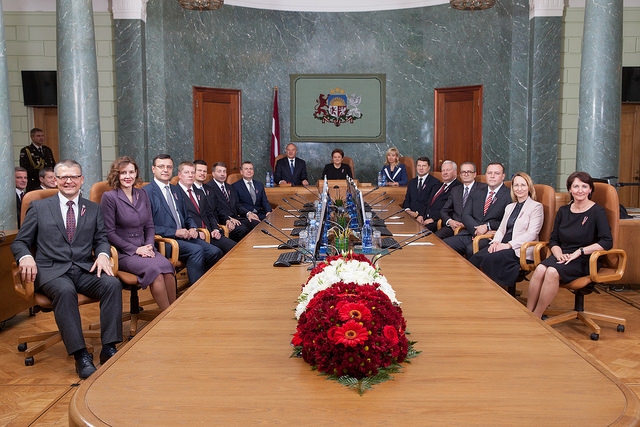By Jānis Ikstens, University of Latvia
The October 2014 parliamentary elections in Latvia were as ruthless as usually – one incumbent political party was swept out of the Saeima while two newcomers cleared the 5 per cent threshold. Unusual was the ability of parties that supported the Straujuma cabinet since January 2014 to gain more support than in the previous elections of 2011. This runs contrary to the familiar pattern of aggregate losses for coalition parties that could be observed also in Latvia.
James Carville would offer a concise and legendary explanation – „the economy, stupid!”. Indeed, coalition parties could take pride not only in taking Latvia to the Eurozone but also in returning the country to a path of steady (though not spectacular) economic development. After having taken a deep dive in 2009, Latvia’s GDP has been growing above the EU average for several years, salaries in some sectors returned to the pre-crisis levels, and the unemployment dropped below 11 per cent in Q3 2014. The Carvillian interpretation should be taken with a grain of salt – public support for Euro slid well below 50 per cent within four months after the switch to the common currency but emigration was perceived in some quarters as a more efficient means of reducing unemployment than domestic economic growth. Moreover, economic growth did not figure high in the campaign.
It was the war in Ukraine that overshadowed the 2014 elections and generated an unprecedented securitization of campaign debates. The Social Democratic Party “Harmony”, a key protagonist of Russian interests in Latvia that had signed a cooperation agreement with Putin’s ‘United Russia’ party, found its two-pronged campaign strategy shattered as ethnic Latvians increasingly shied away from this party after Crimea. Reliability of some political newcomers was questioned on the grounds of allegedly having developed ties to Russian political or business elites. Governing parties of ethnic Latvians quite unanimously accepted increased defence spending and supported tougher sanctions against Russia. Even seniors scrapped their public actions on the eve of elections to increase old-age pensions in order to avoid an escalation of domestic tensions. Therefore, political context rather than economic considerations prompted the ethnically divided voters to return coalition parties to the parliament in greater numbers.
Although the idea about the need to include ‘Harmony’ in the governing coalition surfaced again, the party’s unclear stance on the war in Ukraine only highlighted broader issues that continued to undermine the coalition potential of ‘Harmony’. As the ‘From Heart to Latvia’ party that was seen as a likely coalition partner of ‘Harmony’ fared poorly in the elections, the Union of Greens and Farmers (UGF) could become game changers. However, a coalition prospect with ‘Harmony’ would likely split UGF.
It was well before the election day that governing parties hinted at their willingness to continue the existing coalition if election results would permit so. Also, President Andris Bērziņš who was to name the next Prime Minister-designate, had shown his support for both the Union of Greens and Farmers inside a coalition and for Laimdota Straujuma as a Prime Minister. Although some tactical manoeuvring aimed at potentially weakening the Greens and Farmers involved the recently established Alliance of Latvia’s Regions, the governing trio of “Unity”, the National Alliance, and the Union of Greens and Farmers emerged soon after the elections.
A more exciting part of coalition negotiations addressed portfolio distribution. Given Laimdota Straujuma’s excellent electoral performance and compromise-oriented persona, no other candidates were seriously considered for the post of Prime Minister. However, for the first time in public, politicians spoke of ‘resource ministries’ overseeing large flows of (EU) funding (f.ex., Ministry of Transportation) and of need to achieve a balanced distribution of the said ministries among coalition partners. Not least, growing tensions within the governing coalition in 2011-2013 have often been attributed to a portfolio skew away from the National Alliance. The Union of Greens and Farmers that had increased its parliamentary representation by half showed the greatest appetite for the resource ministries that was tempered only after several rounds of negotiations leading to a deal with the National Alliance that gave up some of its ambitions in exchange for the position of the Speaker of the parliament.
The distribution of portfolios was sealed by a coalition agreement signed by leaders of all coalition parties and describing rights and obligations of each partner as well as mechanisms of conflict resolution. In line with a long-standing tradition, changes in citizenship, Latvian language and constitution have to have unanimous support of coalition partners. Amendments affecting the state budget is a more recent, post-crisis addition to the list.
The extensive cabinet declaration was compiled rather smoothly. It built on policies of the previous cabinet yet singled out economic development, security and quality of life of an individual and society as top priorities. This declaration departed from numerous predecessors in that it laid out a few measurable milestones of government performance – growth of GDP per capita; inequality; R&D funding etc. Time may tell what the actual priorities will have been – if Laimdota Straujuma will deliver the next New Year’s address to the nation.
Photo source: http://www.bizness.lv/fotozinas/id/27397/laimdotas-straujumas-vaditais-ministru-kabinets


